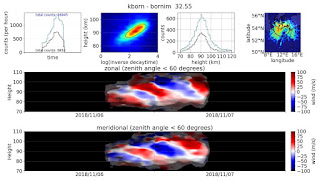Here are some plots that I've seen on the WhatsApp campaign chat. These are all still work in progress, but give an indication of what's going on.
Matthias Clahsen has been processing meteor detections in Bornim, using the new compressive sensing detection, and the meteor radar detection and fitting algorithm. There are about 16000 detections per day for this link, which is pretty good. The zonal and meridional wind fits are also shown in this plot.
 |
| Meteor radar winds and decay times for the Kühlungsborn-Bornim. |
The sparse target model maximum a posteriori estimate (compressive sensing) based target complex scattering amplitude detection provides a near optimal solution to the MIMO radar signal processing task (multiple simultaneous transmitters and multiple receiver). Here is an example plot from Nico, which shows six meteors in a period of 20 seconds.
 |
| Six meteors in 20 seconds. Not a very unusual sight with the system. |
The cool part about software defined radio, is that the same system can also be used to listen into another radar. At the same time as the Bornim system listens in on the Kühlungsborn spread spectrum transmitter, and detects lots of meteors, it can also listen in on the pulsed radar transmitter in Juliusruh. Here are meteor trails detected for the Juliusruh-Bornim path -- at the same time!
 |
| Pulsed radar echoes detected in Bornim. The slight broad range increases in noise are due to strong spread spectrum radar echoes illuminated by the coded CW radar in Kühlungsborn. They don't cause a lot of interference for the pulsed system, because the signal is spread over time and frequency. |
There have been quite many bright fireballs, which have been observed during the campaign. Sometimes they leave a trail that can least for a long time. Here is one example of a bright fireball, which Miguel Urco processed last night, with higher time resolution than normal.










Comments
Post a Comment